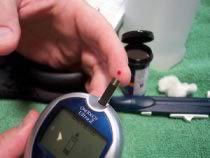Vitamin E and Diabetes - Vitamin E for Lowering the Risk of Diabetic Complications
| Share on Facebook | Share on Twitter | Share on Google+ |
Diabetes is an insidious disease, and the complications of diabetes often don't seem to make a lot of sense.
Some diabetics don't manage their blood sugars very well, but don't get complications. Other diabetics tend to let their blood sugars run a little too high, but don't have complications ten, fifteen, twenty, or even thirty years after developing the disease. Part of the reason for these variations in diabetic outcomes is due to differences in the consumption of vitamin E and other antioxidants.
If blood sugar levels are left unchecked for years, diabetics often experience:
- Diabetic neuropathy, the stinging, tingling, and numbness caused by nerve damage
- Diabetic retinopathy, the loss of sight due to damage to the retina
- Diabetic nephropathy, potentially fatal loss of detoxifying capacity in the kidneys
- Cardiovascular complications, including hardening of the arteries, heart attack, and the ischemic kind of stroke
- Loss of erectile function in men
- A condition of chronically sluggish digestion known as gastroparesis, caused by diabetic damage to the vagus nerve.
If you want to avoid these complications, you really need to keep you blood sugar levels in check all day every day of your life.

But the simple fact is that antioxidants like vitamin E go a long way toward preventing the horrible complications of the disease, even if you blood sugar control is not perfect. Here are ten things every diabetic needs to know about vitamin E and diabetic complications.
1. Diabetics are particularly prone to hardening of the arteries. Vitamin E helps prevent the oxidation of LDL cholesterol, the first step in calcification and stiffening of the arterial wall.
2. For diabetics who already have arterial plaques, vitamin E slows the activity of an enzyme called PKC. This prevents the formation of additional layers of hardened plaque and further clogging of arteries.
3. Even after vitamin E has done its work as antioxidant, it is still useful as an anti-coagulant. A byproduct of the alpha-tocopherol form of vitamin E known as alpha-tocopheryl quinone stops the formation of blood clots that block clogged arteries.
4. Another of the dreaded complications of long-term diabetes is kidney failure. The form of natural vitamin E known as d-alpha-tocopherol slows down the leakage of proteins from the kidneys that destroy the fine tubules used to clean the bloodstream.
5. A byproduct of gamma-tocopherol known as LLU-alpha helps the kidneys get rid of sodium while keeping other electrolytes the body needs. This reduces blood pressure and also helps the heart beat more easily and regularly.
6. Diabetics are at heightened risk for developing cataracts, clouding of the lens of the eye that can steal vision. Interestingly, the diabetic who develop cataracts are also at increased risk for Alzheimer's disease. Danish scientists believe that vitamin E can slow down the development of both conditions.
7. Diabetics who consume relatively vitamin E and vitamin C are at high risk of an eye condition called macular degeneration, in which sight is lost in the middle of the field of vision. Supplementing with 100 IU or more of natural vitamin E and low doses of vitamin C (no more than 500 mg a day, because of the interaction of higher doses of vitamin C and high blood sugars), using sunglasses when outdoors, and getting daily servings of colored vegetables for lycopene, lutein, and zeaxanthin may slow this condition.
8. High-dose injected vitamin E is sometimes used as a treatment for neuropathy, the painful nerve damage followed by loss of sensation altogether, caused by years of uncontrolled blood sugar levels. You should never try to inject yourself with vitamin E-there is more inside a vitamin E capsule than vitamin E, and exposing the contents to the air ruins the antioxidant power of the vitamin-but you may benefit from taking a relatively high daily dosage of vitamin E (1,200 IU a day) if you already have this problem.
9. Sometimes vitamin E stops burping, belching, and gas in type 2 diabetics. Long-term damage to the vagus nerve slows the passage of food through the digestive tract, so that it "ferments." Vitamin E helps the vagus nerve recover so that food passes more quickly and digestive upset is less frequent.
10. Diabetics often get age spots. Skin creams that contain vitamin E, vitamin C, and alpha-lipoic acid can help erase age spots.Except as otherwise indicated, the usual dosage of vitamin E for diabetic support is 400 IU of alpha-tocopherol plus 400 mg of tocotrienols. If you take any medication to thin the blood, consult with your doctor before beginning vitamin E.
Selected References:
Garner B, Roberg K, Qian M, Brunk UT, Eaton JW, Truscott RJ. Redox availability of lens iron and copper: implications for HO generation in cataract. Redox Rep. 1999;4:313-5.
Surolia I, Sinha S, Sarkar DP, Reddy PY, Reddy GB, Surolia A. Concurrence of Danish dementia and cataract: insights from the interactions of dementia associated peptides with eye lens alpha-crystallin. PLoS One. 2008;3:e2927
-
Skin CareMen Skin Care
-
Free ResourcesFree eBooks
-
Be careful in reading health books. You may die of a misprint.Mark Twain
-
Featured Health SupplementTotal Balance
 provides a broad spectrum of around 80 of the nutrients that your body needs…including vitamins, minerals, trace elements, antioxidants, amino acids, neuronutrients, bioflavonoids, carotenoids, herbal extracts, enzymes and other complementary co-factor ingredients.
provides a broad spectrum of around 80 of the nutrients that your body needs…including vitamins, minerals, trace elements, antioxidants, amino acids, neuronutrients, bioflavonoids, carotenoids, herbal extracts, enzymes and other complementary co-factor ingredients.
-



















